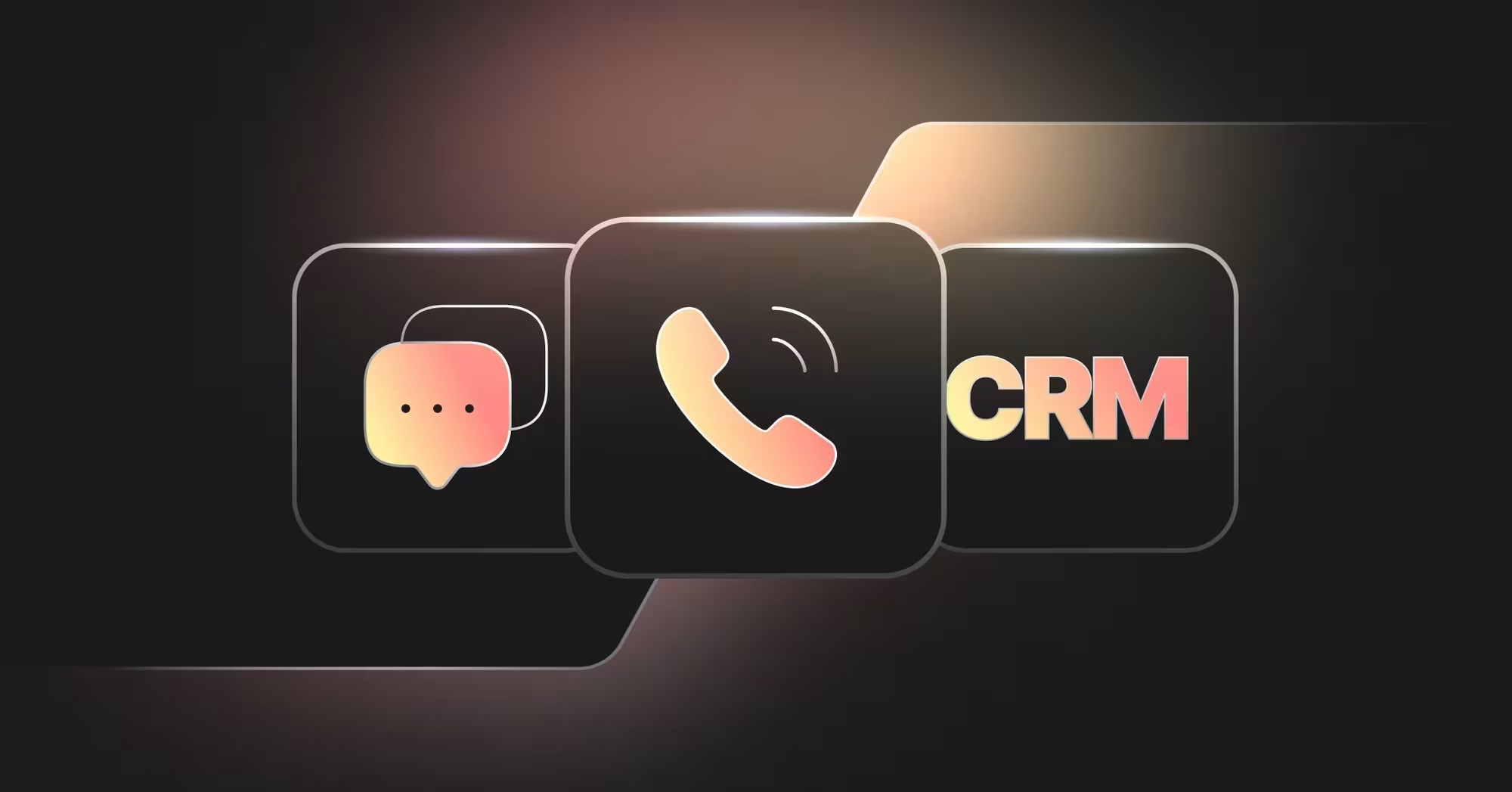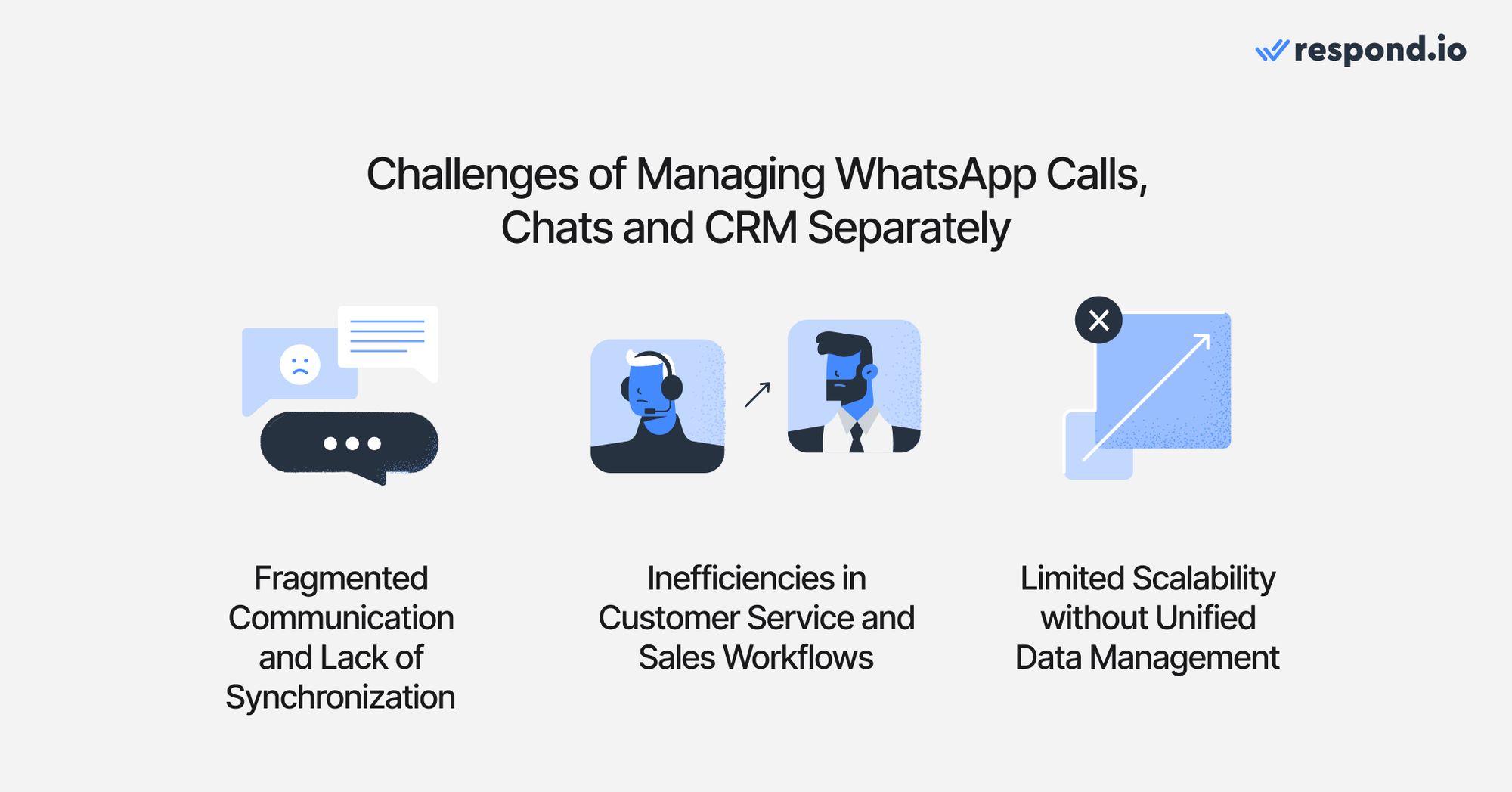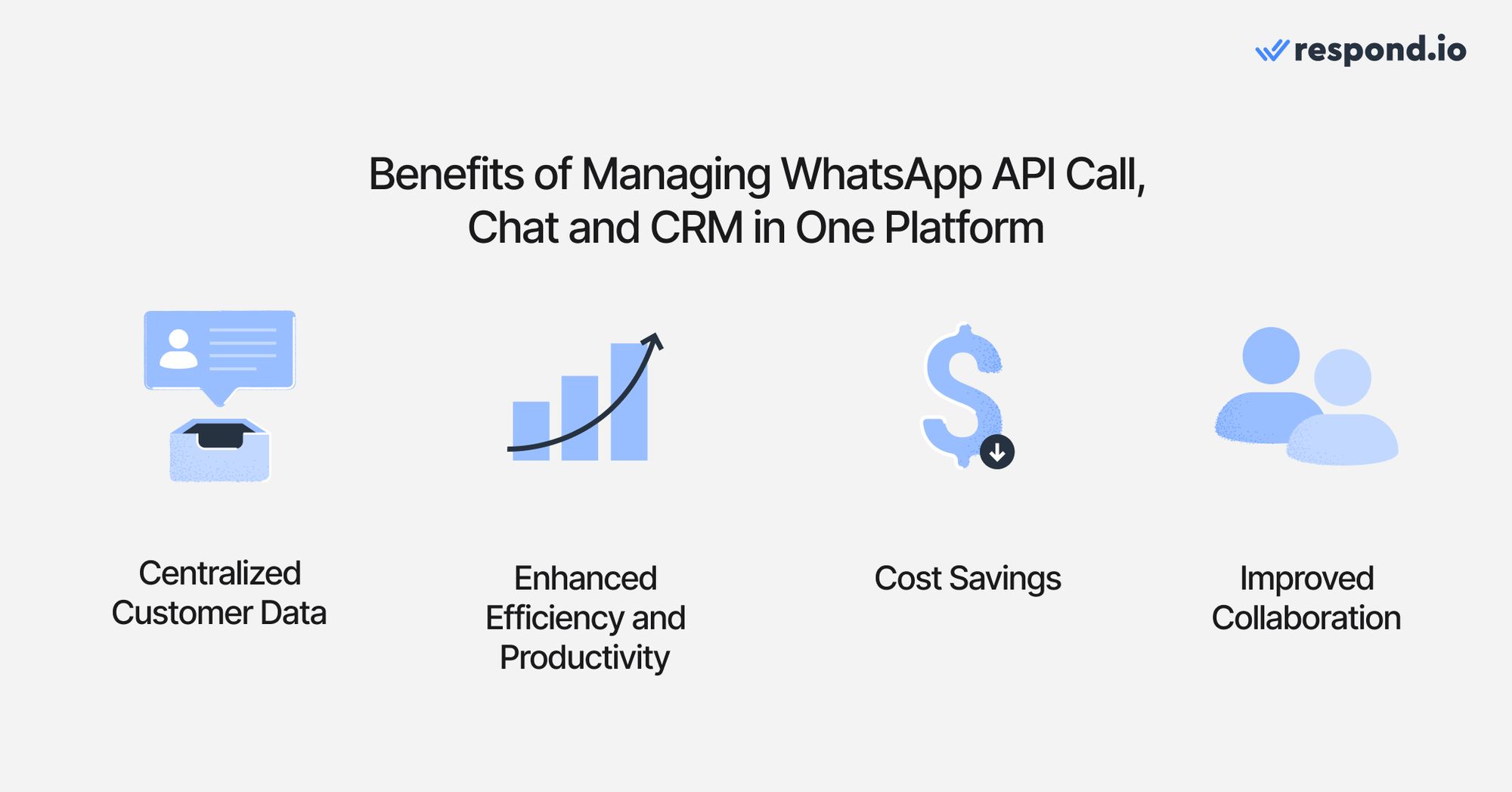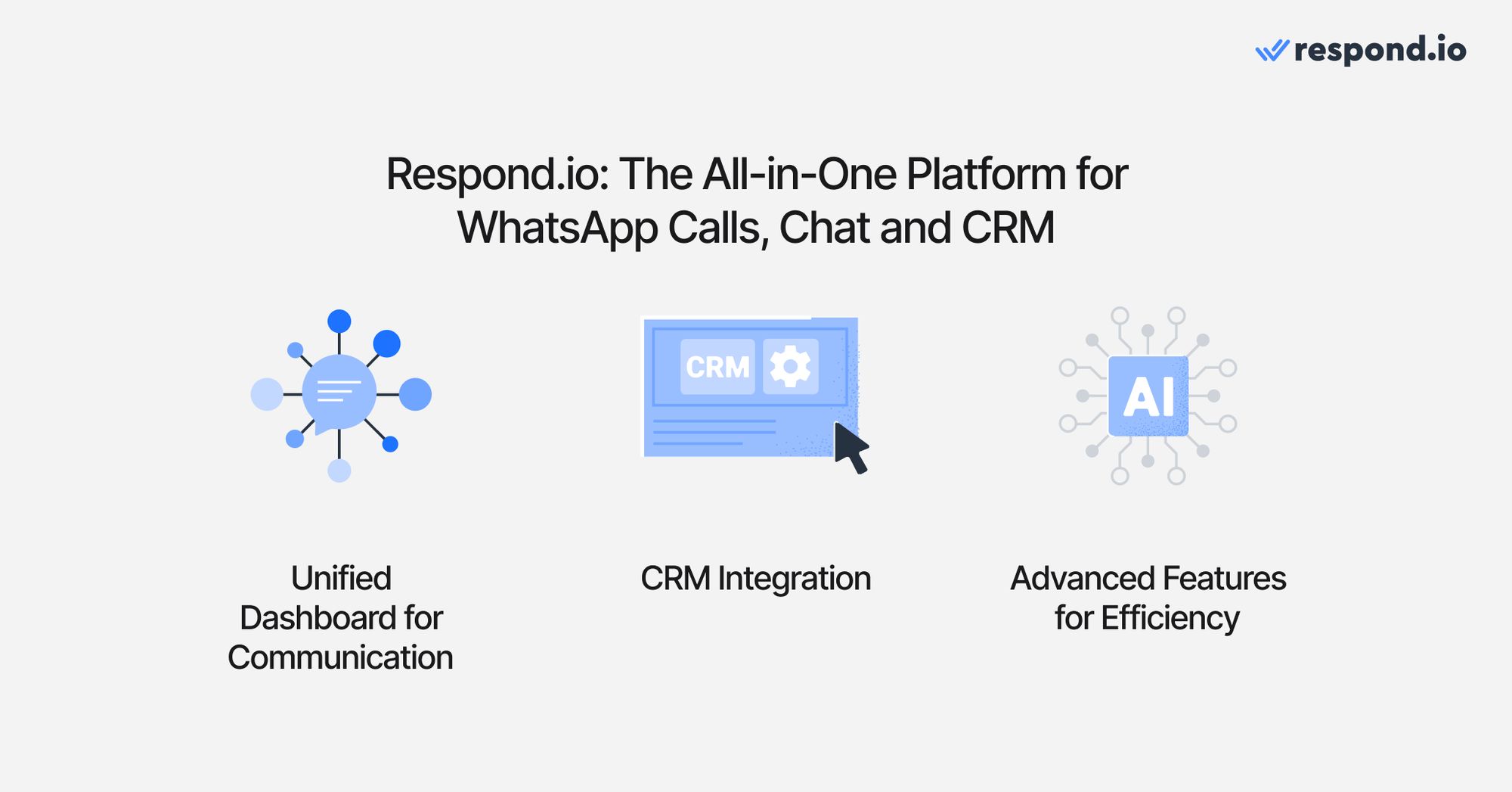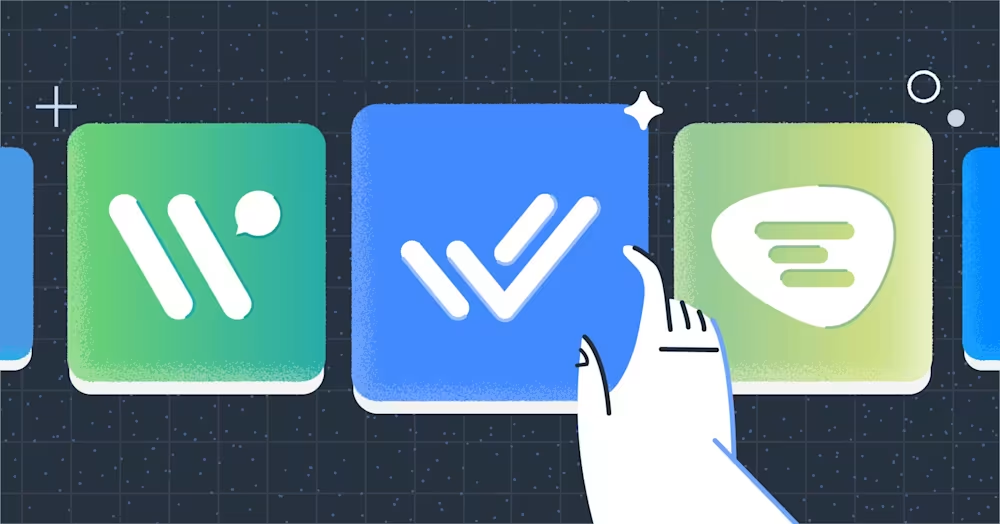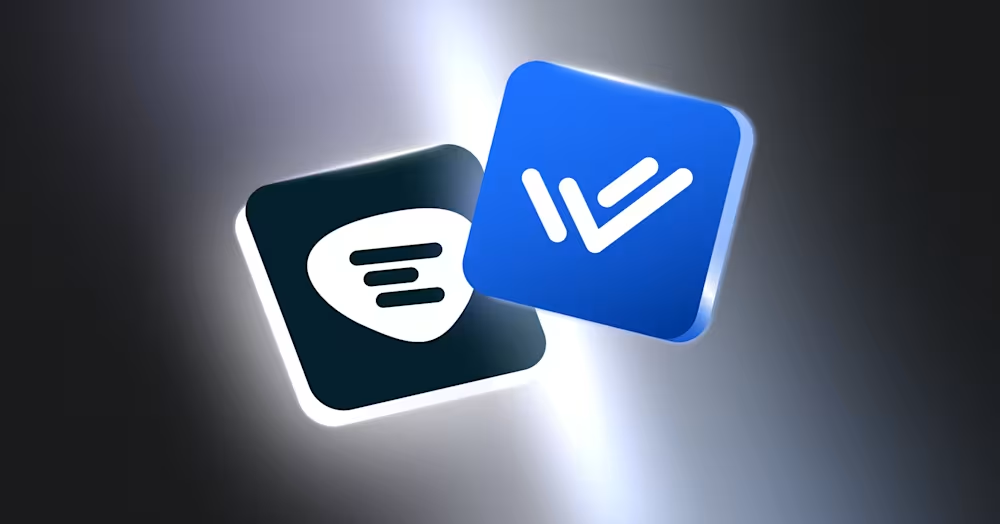Las empresas confían hoy en WhatsApp más que nunca para conectar con clientes potenciales y clientes. Pero el malabarismo de llamadas, chats y CRMs puede ser caótico y consume mucho tiempo. Puede que te estés preguntando, ¿cuál es la solución? y ¿cómo puedo administrar las llamadas, chats y CRMs de la API de WhatsApp en una sola plataforma?.
La respuesta es simple: necesitas una forma de reunirlos a todos.
¿Tienes curiosidad por saber cómo? Sigue leyendo. A continuación, nos sumergiremos en por qué gestionar estos canales por separado te retiene, cómo una plataforma unificada beneficia tu flujo de trabajo y por qué responde. o es la solución que necesitas.
Desafíos al gestionar las llamadas de WhatsApp, chats y CRM por separado.
Todos sabemos que intentar gestionar diferentes herramientas de comunicación en silos es una receta para el desastre. pero veamos más de cerca por qué este es el caso:
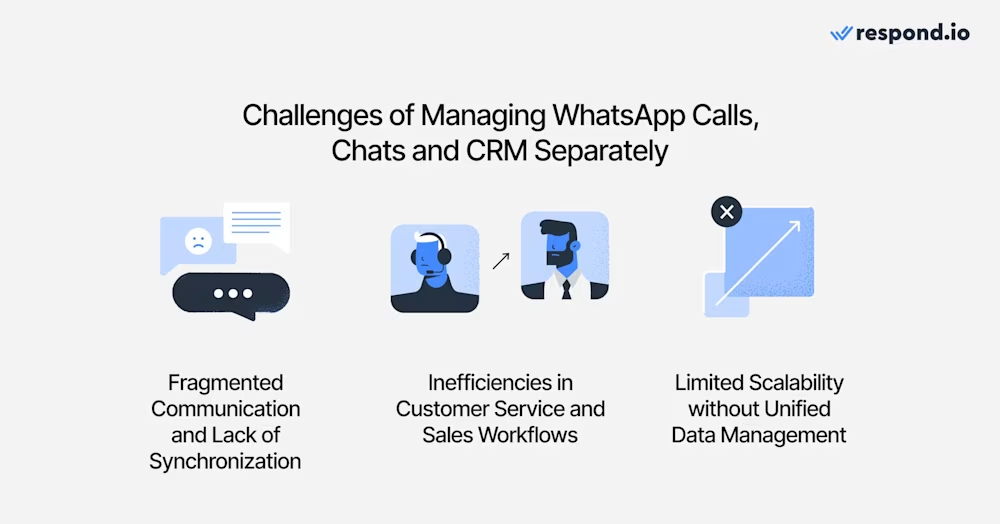
Comunicaciones fragmentadas
La comunicación cohesiva es la columna vertebral de todas las ventas WhatsApp y actividades de marketing. Así que imagina si tuvieras que equilibrar llamadas de WhatsApp, chats y herramientas de gestión de relaciones con clientes (CRM) en plataformas separadas. Sería una experiencia confusa y potencialmente perturbadora.
Por ejemplo, si un cliente potencial pasa de un chat de WhatsApp a una llamada, la falta de contexto entre diferentes plataformas puede generar errores y oportunidades perdidas.
Flujos de trabajo ineficientes
Cambiar entre plataformas no es sólo molesto. Es totalmente ineficiente, y cuando se trata de ventas y mercadotecnia, la ineficiencia significa pérdida de tiempo. La velocidad importa en las ventas, por lo que reducir los tiempos de respuesta significa agregar más fricción a sus embudos de ventas.
Esto puede llevar a que tus clientes potenciales se pierdan y tus clientes tengan que esperar más, lo que genera insatisfacción. Y en el peor de los casos, optar por dejarte e irse con un competidor.
Escalabilidad limitada
A medida que su negocio siga creciendo, también lo hará su lista de clientes potenciales y clientes. Aunque podrías arreglártelas sin tener un sistema centralizado para gestionar tus llamadas, chats y CRM al principio, esto rápidamente resultará ser un error fatal más adelante.
Pronto se sentirá como resolver un rompecabezas sin ver la imagen completa. Sin un sistema claro, tus equipos no solo tendrán problemas para seguir el ritmo de los clientes potenciales, sino también para mejorar las campañas y entender qué funciona.
Beneficios de gestionar las llamadas de la API de WhatsApp, chats y CRM en una sola plataforma.
La solución a lo anterior es simple: necesita una plataforma de comunicación única y unificada que gestione llamadas, chats y CRMs.
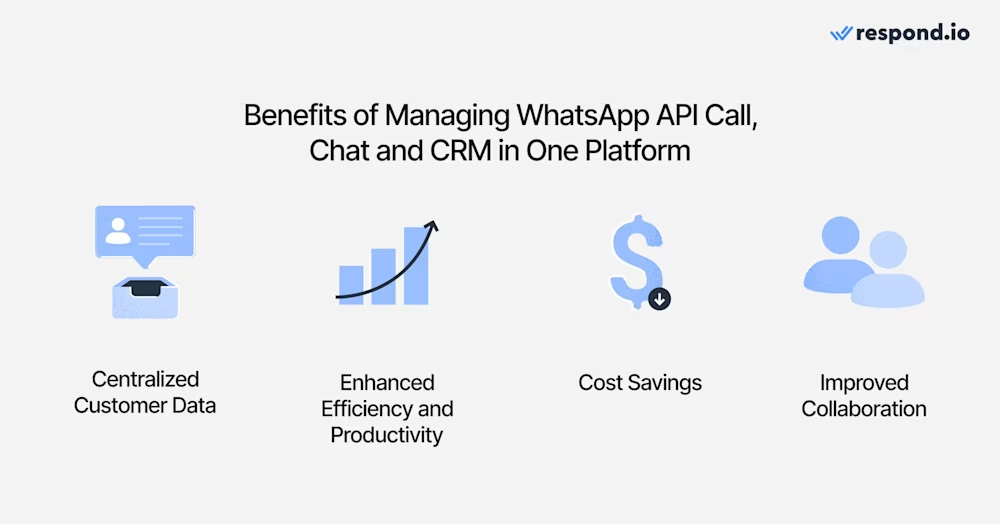
Cuando todos sus canales de comunicación viven bajo un mismo techo, aquí está cómo te beneficia:
Datos centralizados del cliente
Reunirlo todo proporciona a sus equipos una visión completa del viaje al cliente. Esto significa que en el momento en que entra un mensaje o una llamada, aparece en una bandeja de entrada compartida, permitiendo a sus equipos obtener rápidamente el contexto que necesitan para manejar sus conversaciones. ¡No busque más detalles de la conversación más reciente o compre tres aplicaciones diferentes sólo para confirmar una compra o un problema anterior!
Eficiencia y productividad mejoradas
Una plataforma consolidada reduce el tiempo necesario para actualizar registros, llamadas a registros, chats de respuesta y asignar prospectos. Los equipos pueden saltar de una tarea a otra sin copiar y pegar información a través de diferentes plataformas, haciendo que los flujos de trabajo sean aún más productivos.
Ahorros de coste
Pagar por múltiples herramientas es un despilfarro de dinero, especialmente cuando no es necesario. Cada suscripción se suma y los costes administrativos de gestionar diferentes ciclos de facturación y licencias. Al combinar llamadas, chats y CRMs en una sola plataforma, te darás cuenta rápidamente de lo que puedes cortar y ahorrar más.
Colaboración mejorada
Mantener conversaciones fácilmente accesibles hace que sea más fácil para todos, desde ventas hasta apoyo y marketing y más adelante, para colaborar. Si el marketing quiere ver cómo los clientes responden después de una nueva campaña, pueden mirar el historial de mensajería. Si las ventas necesitan un aporte rápido en la consulta de un cliente potencial, pueden ver el chat relevante y agregar notas directamente.
Convierte conversaciones en clientes con la API oficial de WhatsApp de respond.io. ✨
¡Gestiona llamadas y chats de WhatsApp en un solo lugar!
Respond.io: Plataforma Todo en Uno para llamadas de WhatsApp, Chat y CRM
Así que sabe que necesita una solución todo en uno, pero ¿cómo lo pone en práctica? Sencillamente. Te vuelves hacia soluciones como respond.io que integran llamadas, chats y capacidades de CRM en un único paquete fácil de usar.
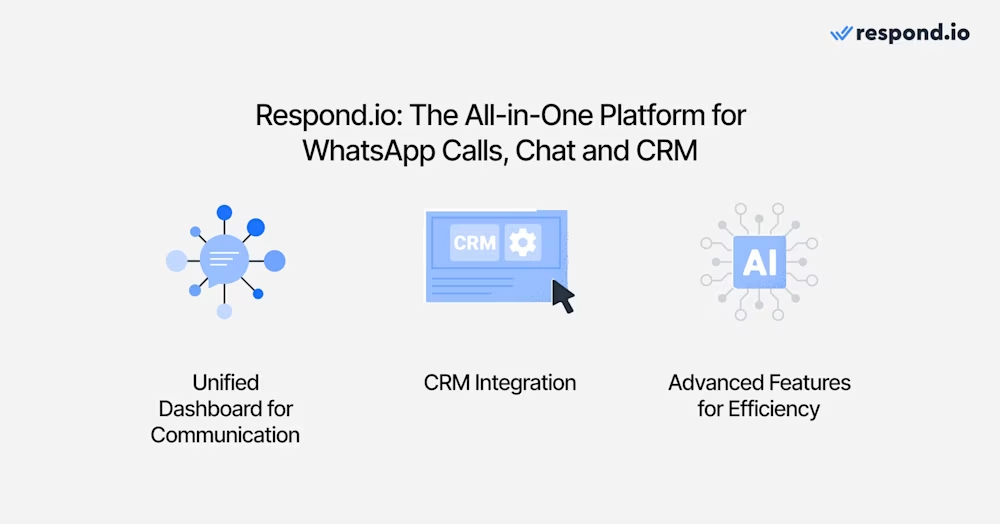
Panel unificado para la comunicación.
Respond.io te da un panel centralizado para todas las interacciones de WhatsApp. El segundo en que recibe un nuevo mensaje o llamada, aparece en una bandeja de entrada compartida. Los equipos pueden ordenar conversaciones por prioridad, etiquetarlas y asignarlas a la persona correcta. Esto significa que se deslizan menos tareas y que tu equipo puede manejar múltiples conversaciones con mayor eficacia.
Mejor aún, la transición perfecta entre conversaciones y llamadas significa que no tienes que cambiar de herramientas si una conversación basada en texto de repente requiere una llamada de voz: ¡todo sucede bajo un mismo techo!
Integración CRM
Otra ventaja importante es cómo respond.io maneja sus necesidades CRM. Obtén datos centralizados del cliente para interacciones personalizadas: todo el contexto necesario para adaptar cada conversación.
Además, por automatizar los flujos de trabajo de los clientes, el seguimiento de clientes potenciales se vuelve más fácil. Puede asignar automáticamente los clientes potenciales a representantes específicos, envía recordatorios de seguimiento y mueve perspectivas a través de tu tubería basándose en cómo se comprometen con tus mensajes de WhatsApp.
Características avanzadas para la eficiencia
Respond.io también viene empaquetado con herramientas de AI para la automatización del chat, por lo que chatbots puede manejar preguntas de rutina 24/7. Si surge algo más complejo, el bot transfiere sin problemas a un agente humano, manteniendo todo el contexto intacto.
Mientras tanto, los informes y análisis para mejorar el rendimiento le permiten realizar un seguimiento de métricas como los tiempos de respuesta promedio y las tasas de conversión. Estos datos le muestran dónde destaca su equipo y dónde puede querer modificar su enfoque.
Cómo empezar con las llamadas API de WhatsApp
Configurar las llamadas de la API de WhatsApp no es ciencia de cohetes. De hecho, en realidad es mucho más simple de lo que se podría esperar:
Únete al programa Beta de llamadas de WhatsApp API
El primer paso es solicitar acceso al programa beta de llamadas de voz de la API de WhatsApp. Para empezar, póngase en contacto con un proveedor de soluciones empresariales de WhatsApp (BSP) como respond.io.
Como uno de los proveedores beta que ofrece la API de llamadas de WhatsApp, responde. o proporciona acceso temprano a la función de llamadas, dándole la oportunidad de unificar sus llamadas, chats y CRM en una sola plataforma. Esto le permite agilizar las comunicaciones y mantenerse por delante de la competencia.
Una vez que esté inscrito, asegúrese de que su cuenta de negocios de WhatsApp está verificada y lista para la integración de la API. Luego, integre la API con respond.io para comenzar a administrar llamadas y chats desde una sola plataforma. Su BSP le guiará a través de este proceso.
Después de que todo esté configurado—especialmente si lo hiciste a través de respond.io—puedes empezar a aprovechar al máximo las características poderosas de respond.io al administrar las llamadas, chats y CRMs de la API de WhatsApp en un solo lugar.
Convierte conversaciones en clientes con la API oficial de WhatsApp de respond.io. ✨
¡Gestiona llamadas y chats de WhatsApp en un solo lugar!
Preguntas frecuentes (FAQ)
¿Cómo maneja la plataforma la privacidad y seguridad de los datos del cliente?
Respond.io prioriza la seguridad de los datos, cumpliendo con el RGPD y otros estándares mundiales. Todos los datos son cifrados y las empresas conservan el control total de su información.
¿Hay alguna comisión adicional por usar llamadas API de WhatsApp en comparación con los chats?
WhatsApp planea introducir precios competitivos durante la fase beta. Los costos variarán en función del uso y la región, por lo que es mejor consultar a su proveedor de API para obtener detalles específicos.
¿Quién proporciona soporte para dificultades técnicas — Meta o respond.io?
Los Meta y los BSMs usualmente se encargan de asuntos relacionados con las API. ¡Para soporte específico de la plataforma, incluyendo la integración con respond.io, el equipo respond.io está listo para asistir 24/5!
Lectura adicional.
Si te ha gustado nuestro artículo, te invitamos a revisar las siguientes lecturas:
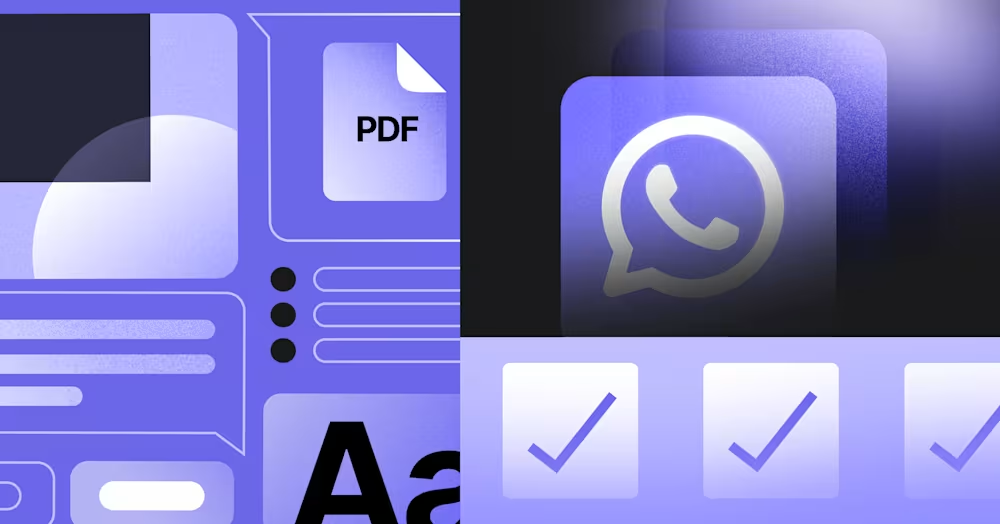



































 Descripción general
Descripción general Electrónico
Electrónico Moda y vestimenta
Moda y vestimenta Muebles
Muebles Joyería
Joyería
 Actividades extracurriculares
Actividades extracurriculares Deportes y fitness
Deportes y fitness
 Centro de belleza
Centro de belleza Clínica dental
Clínica dental Clínica médica
Clínica médica
 Servicios de limpieza y servicio de camareras
Servicios de limpieza y servicio de camareras Fotografía y videografía
Fotografía y videografía
 Minorista de piezas de automóvil
Minorista de piezas de automóvil Concesionario de automóviles
Concesionario de automóviles
 Agencia de viajes y operador turístico
Agencia de viajes y operador turístico

